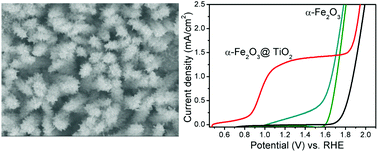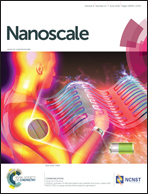Hierarchically branched Fe2O3@TiO2 nanorod arrays for photoelectrochemical water splitting: facile synthesis and enhanced photoelectrochemical performance†
Abstract
Highly photoactive and durable photoanode materials are the key to photoelectrochemical water splitting. In this paper, hierarchically branched Fe2O3@TiO2 nanorod arrays (denoted as Fe2O3@TiO2 BNRs) composed of a long Fe2O3 trunk and numerous short TiO2 nanorod branches were fabricated and used as photoanodes for water splitting. Significant improvement of photoelectrochemical water splitting performance was observed based on Fe2O3@TiO2 BNRs. The photocurrent density of Fe2O3@TiO2 BNRs reaches up to 1.3 mA cm−2 at 1.23 V versus RHE, which is 10 times higher than that of pristine Fe2O3 nanorod arrays under the same conditions. Furthermore, an obvious cathodic shift in the onset potential of photocurrent was observed in the Fe2O3@TiO2 BNRs. More significantly, the Fe2O3@TiO2 BNRs are quite stable even after 3600 s continuous illumination, and the photocurrent density shows almost no decay. Finally, a tentative mechanism was proposed to explain the superior performance of Fe2O3@TiO2 BNRs for PEC water splitting and discussed in detail on the basis of our experimental results.


 Please wait while we load your content...
Please wait while we load your content...